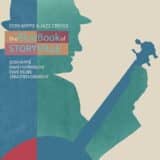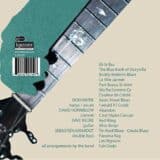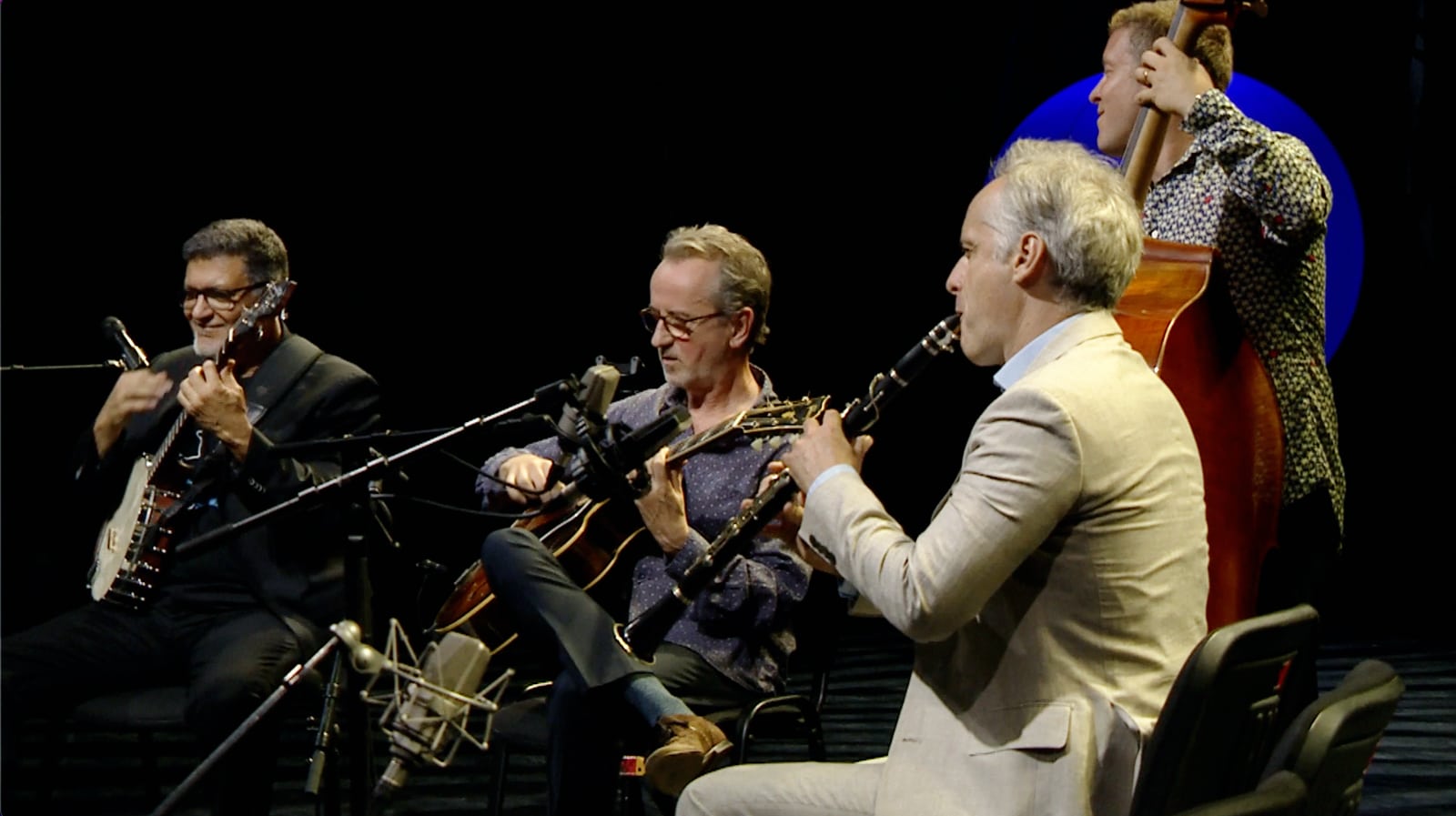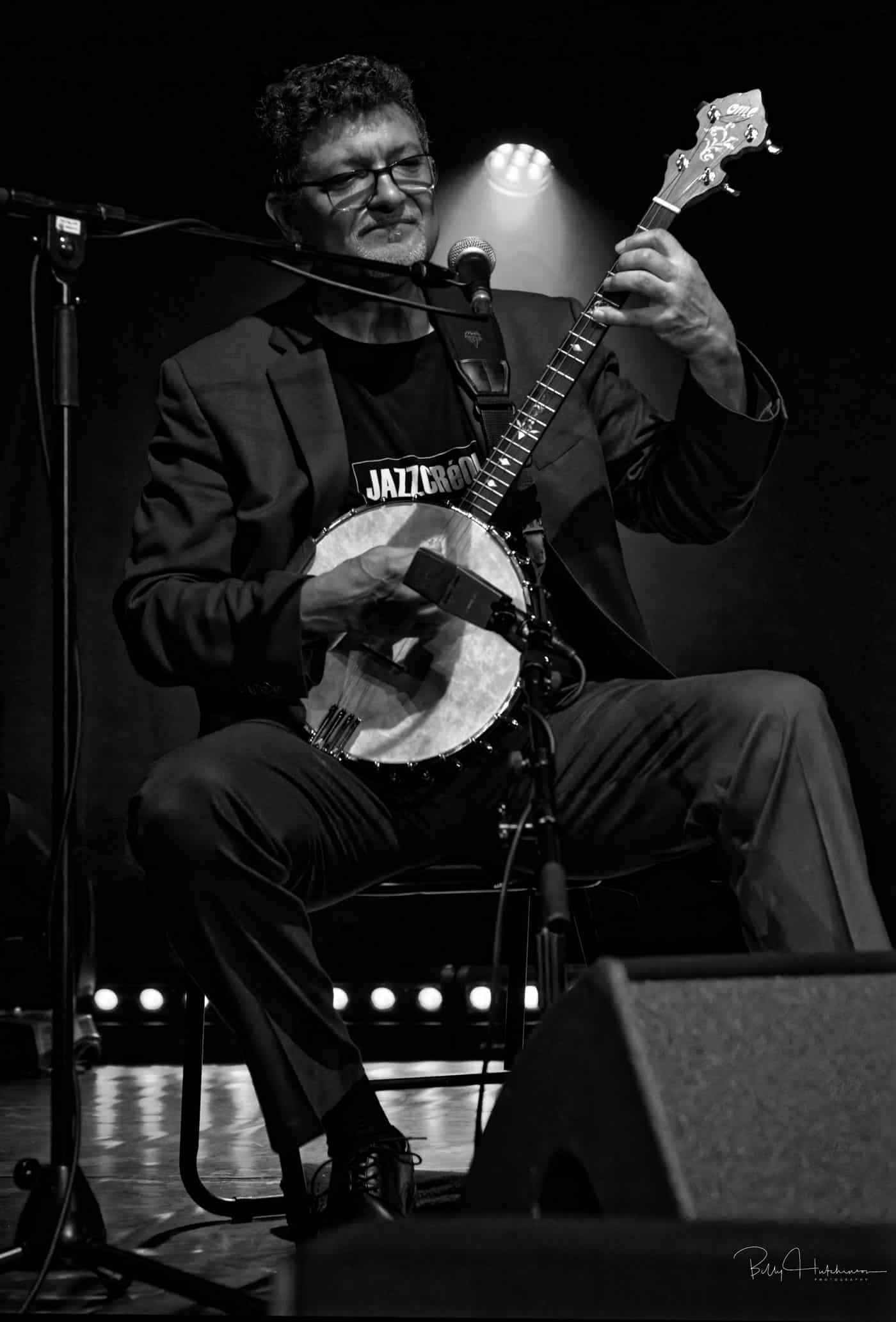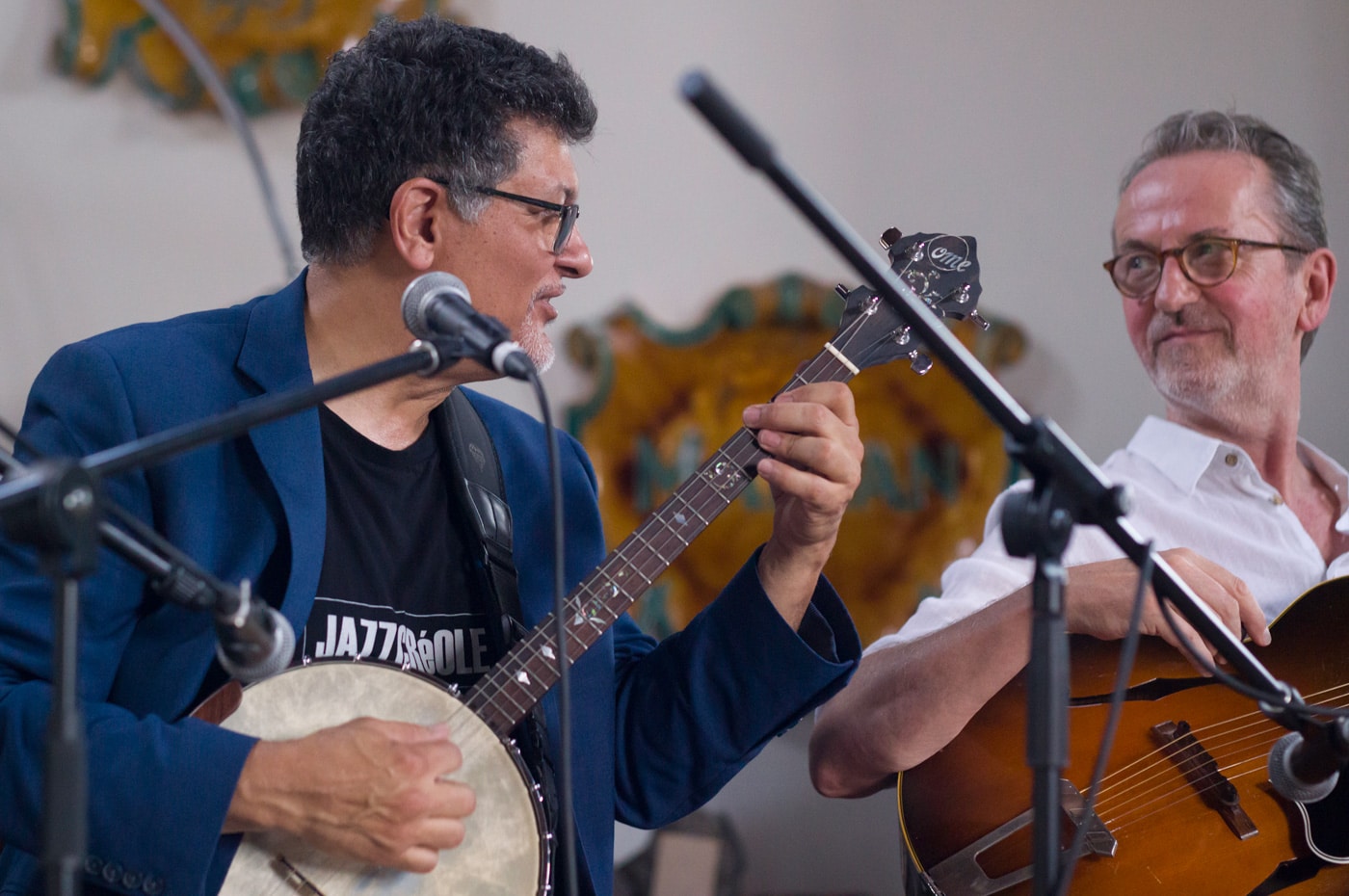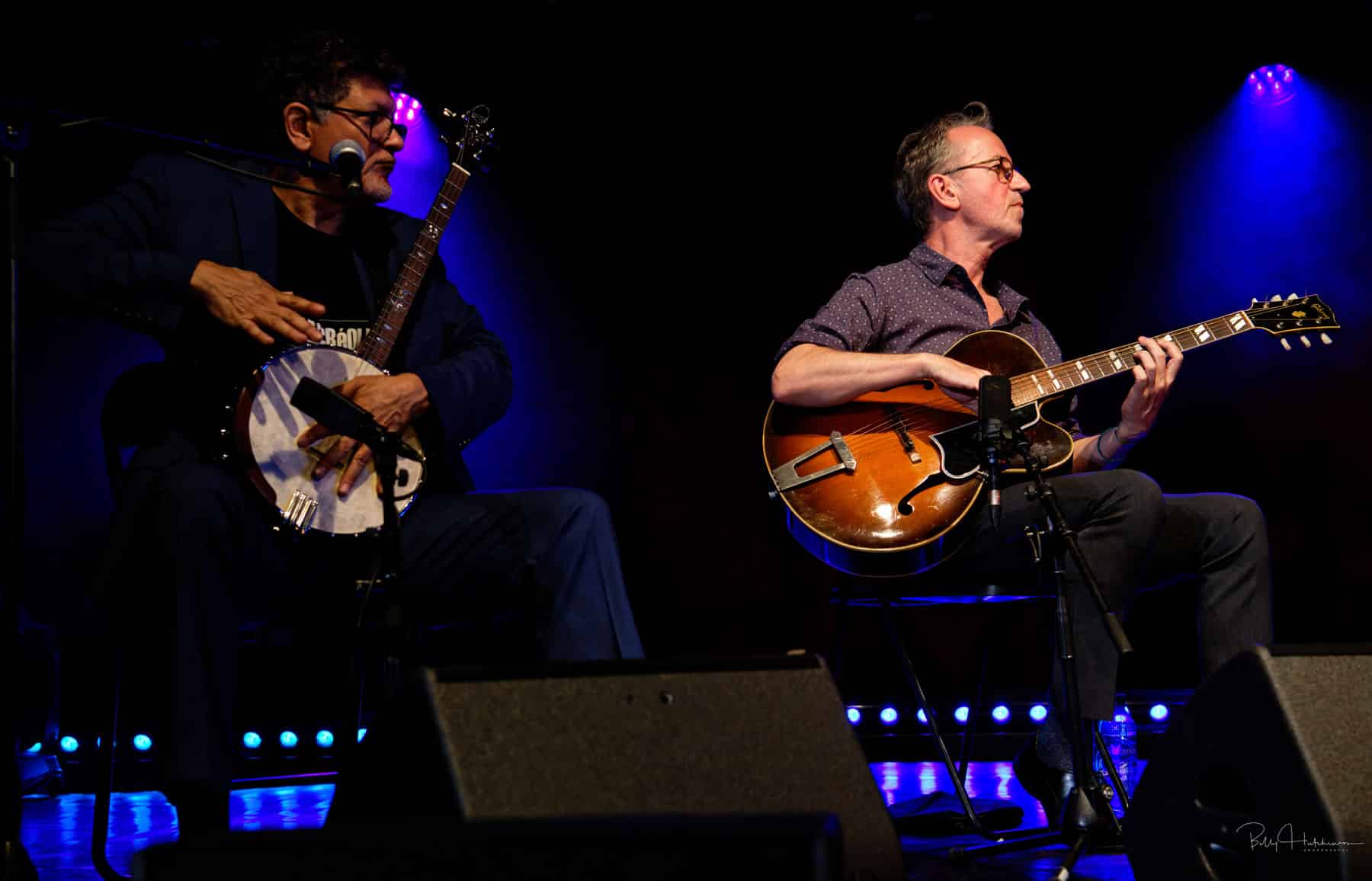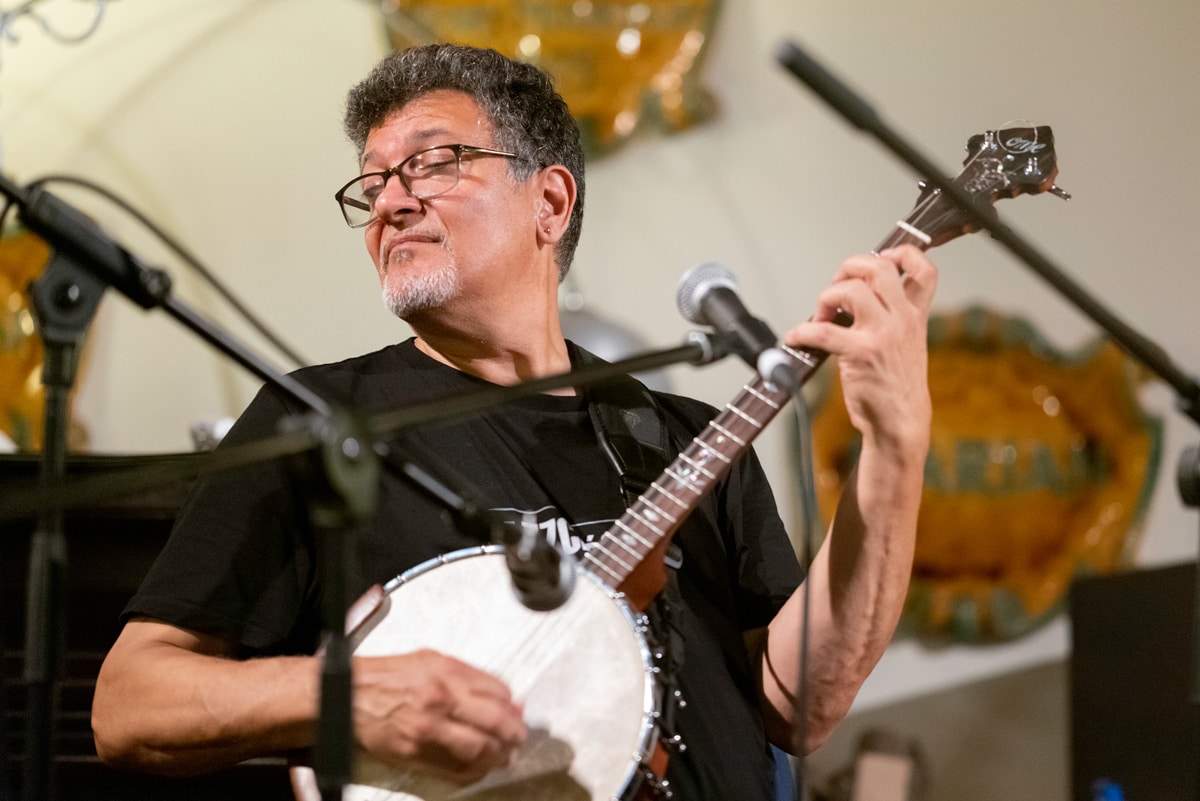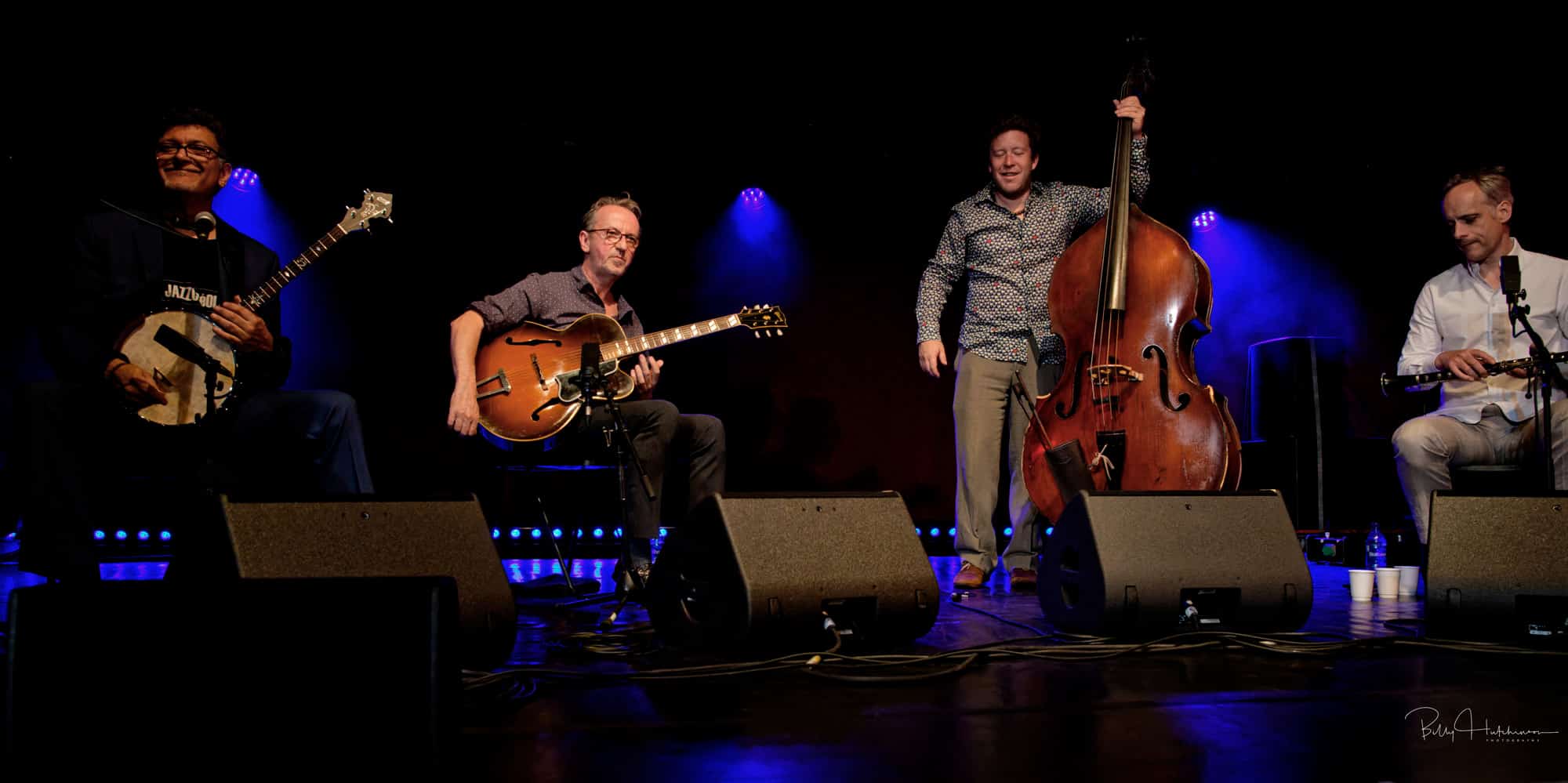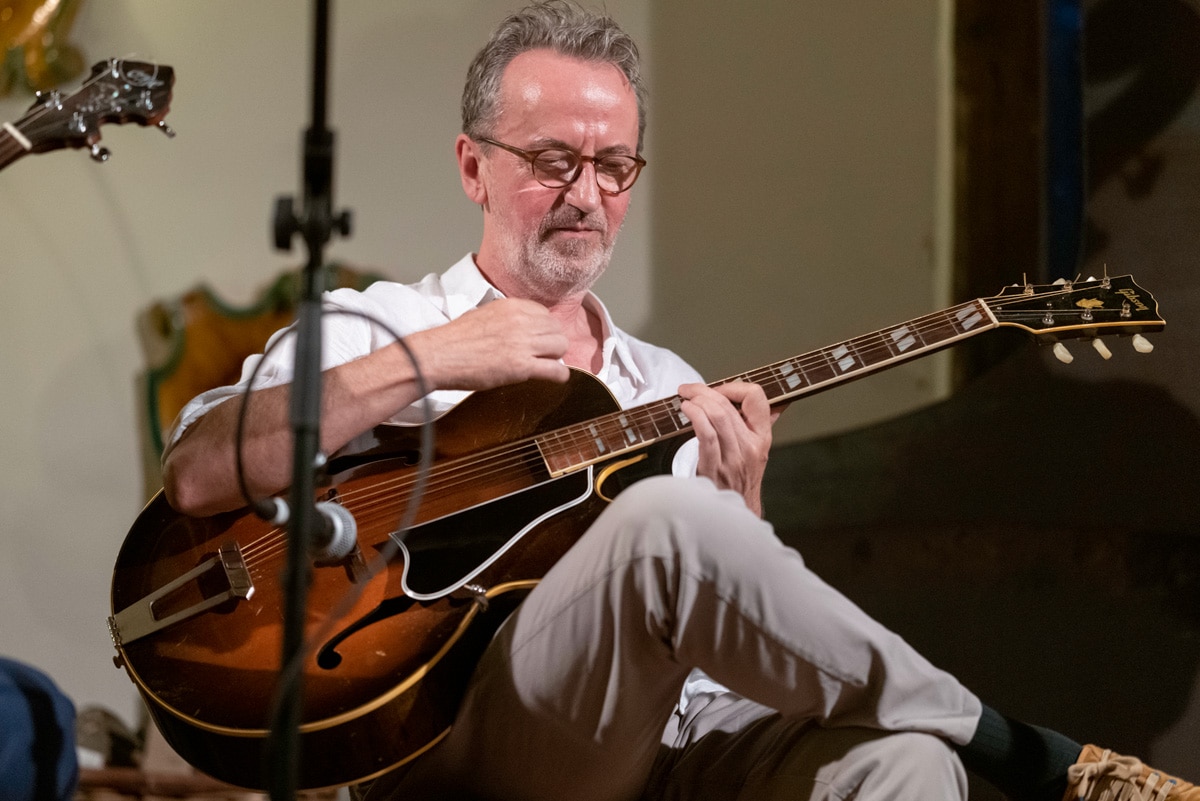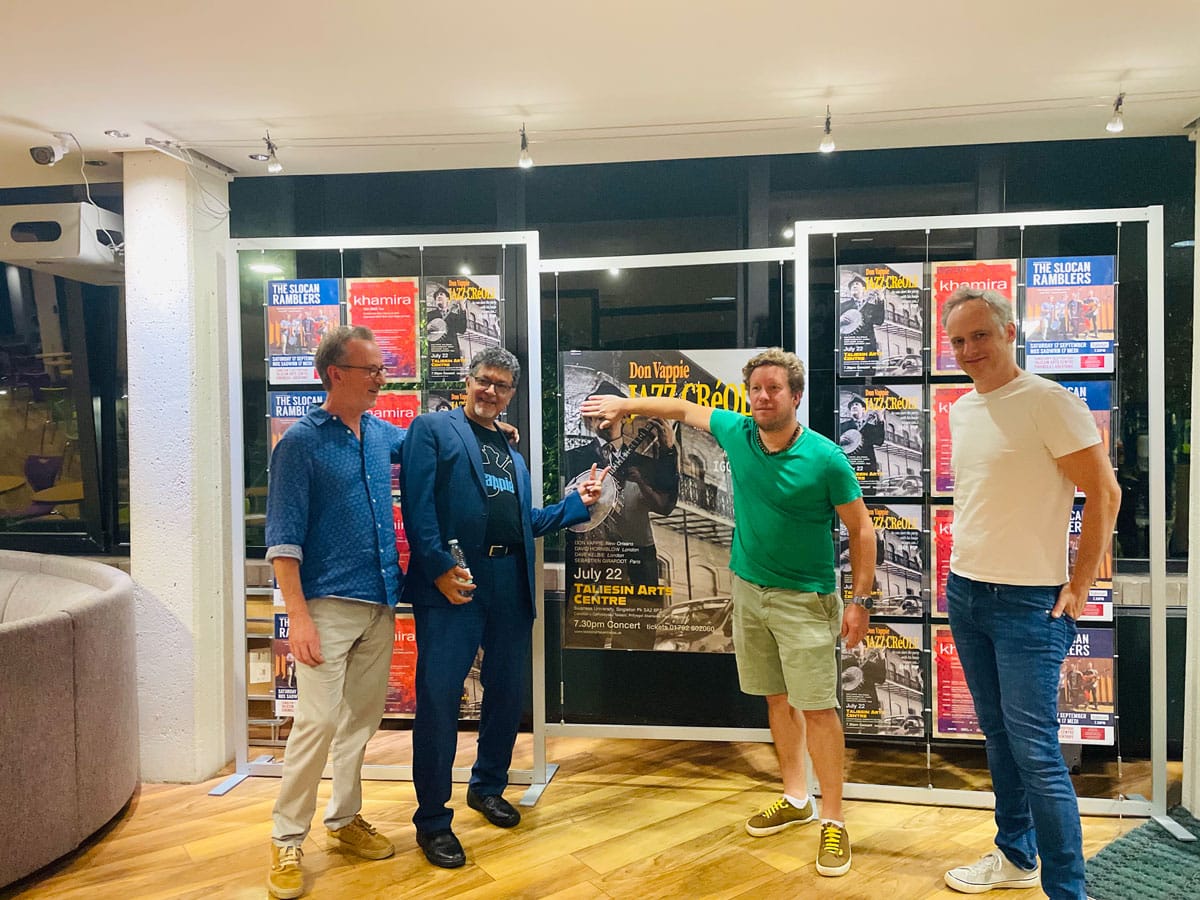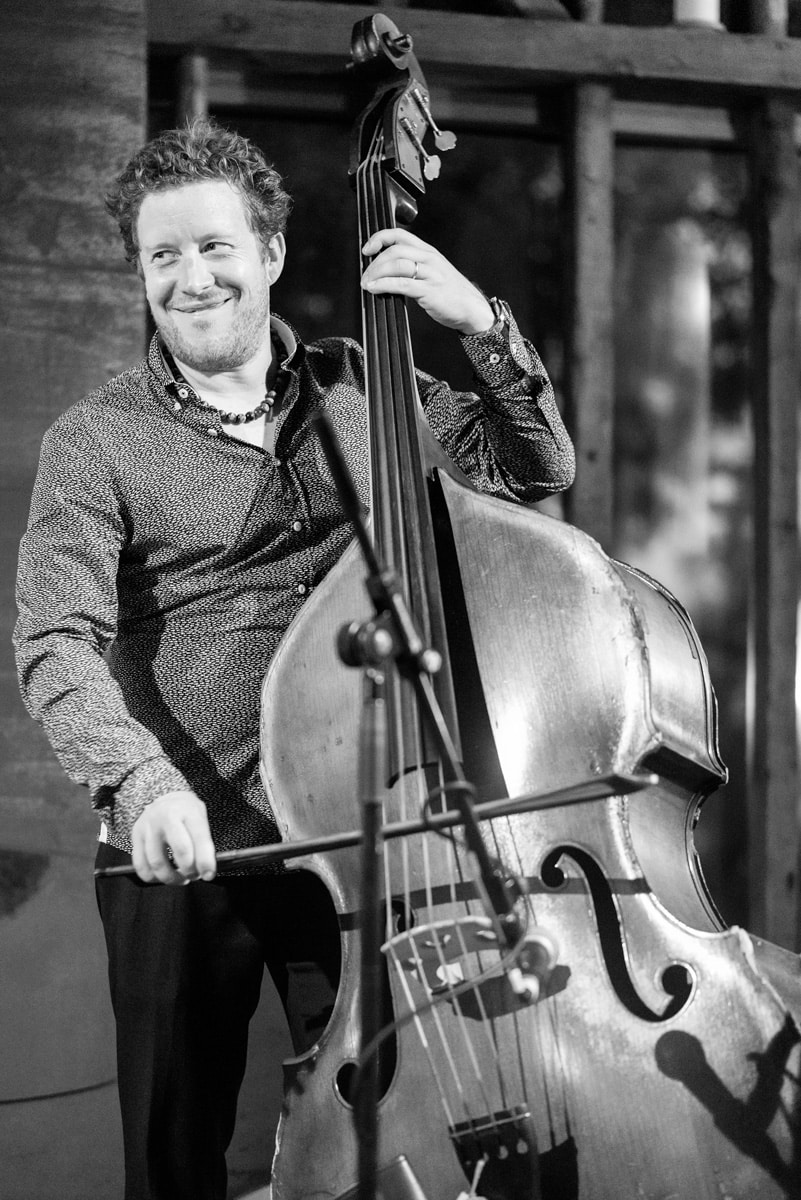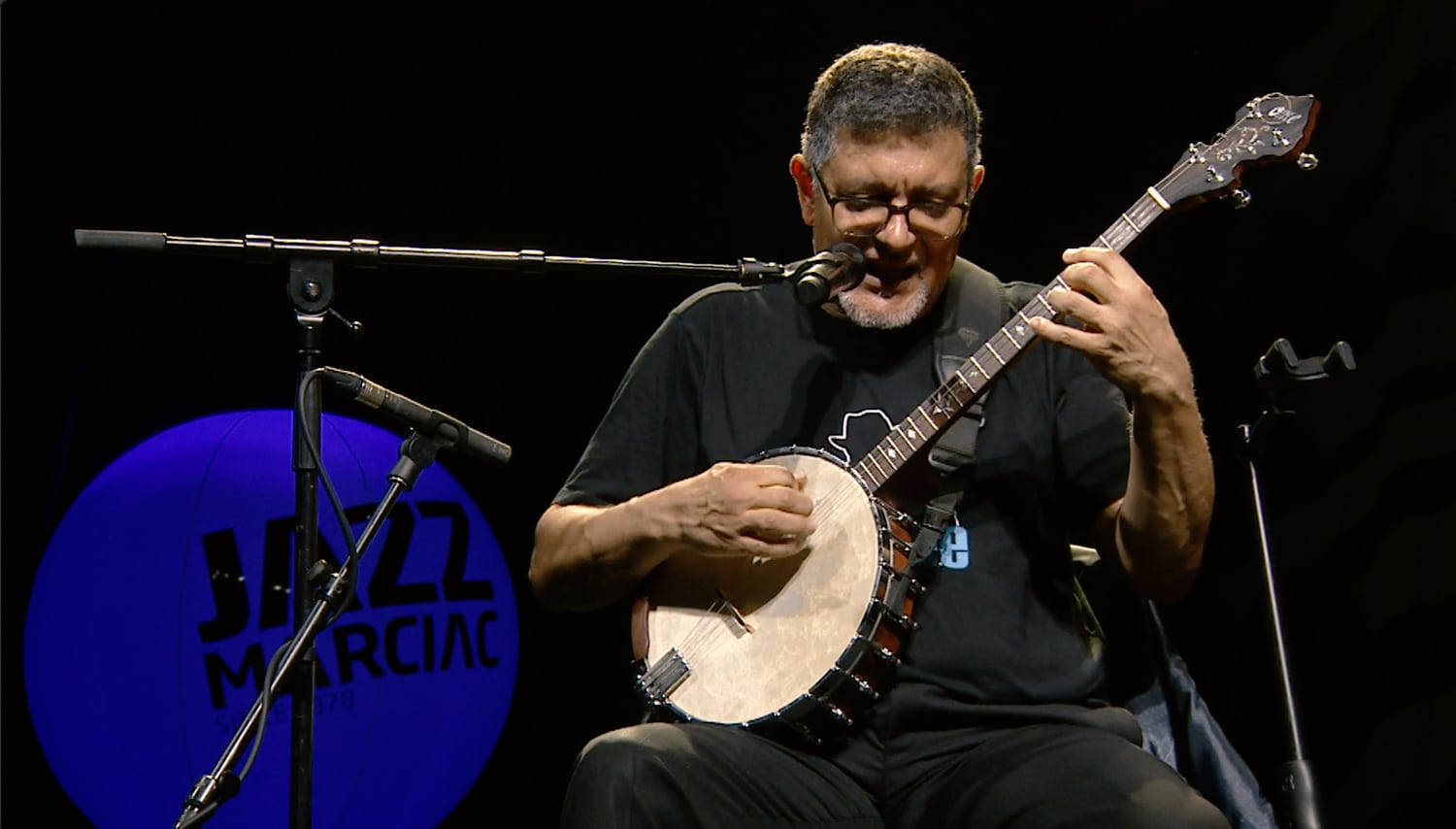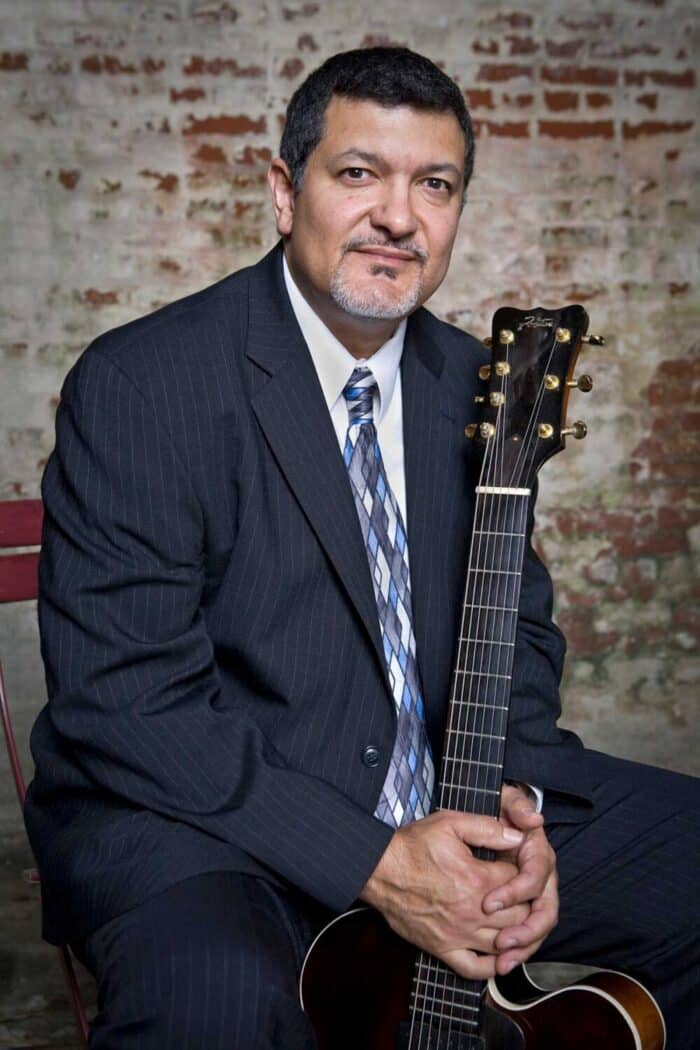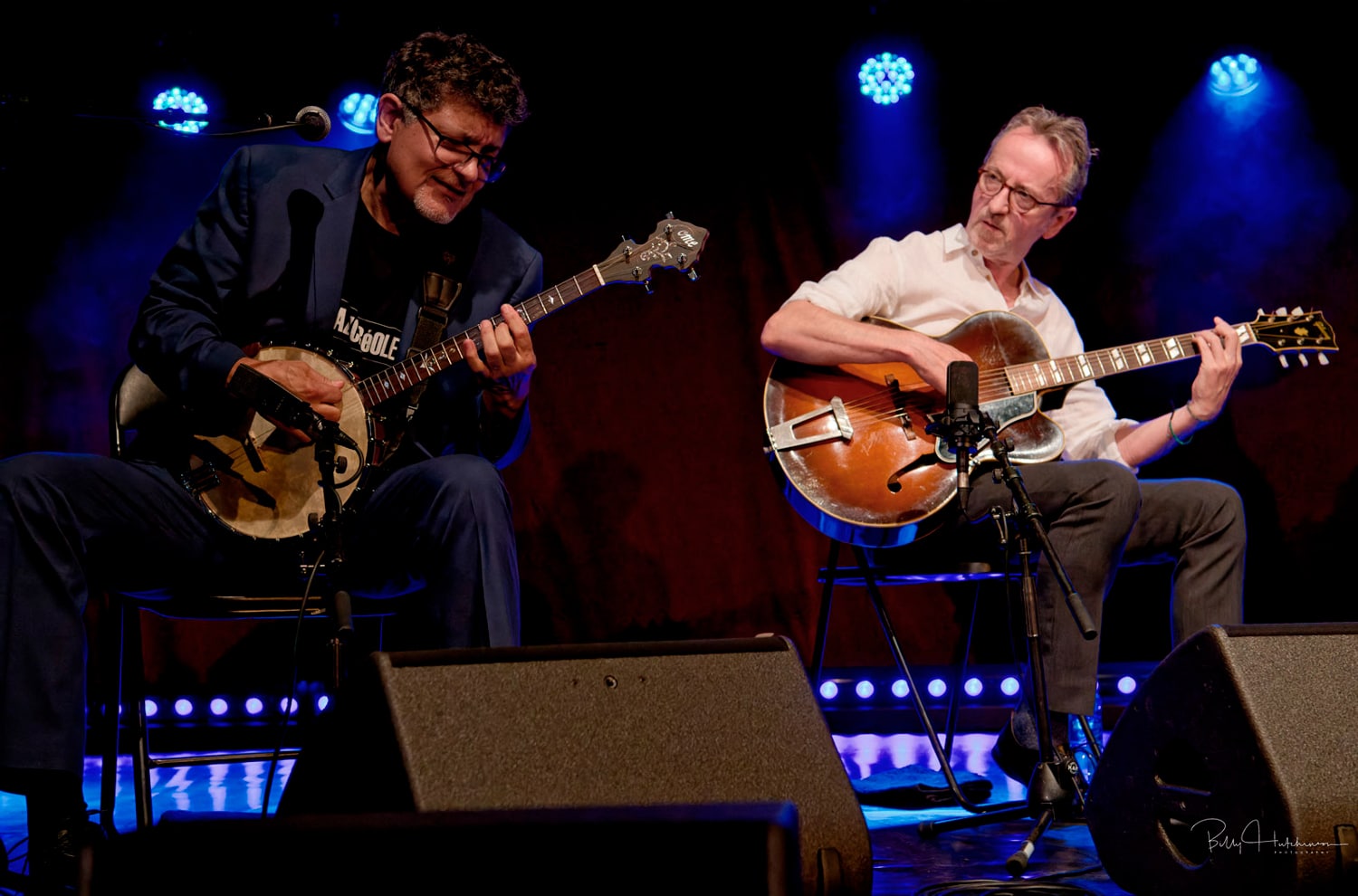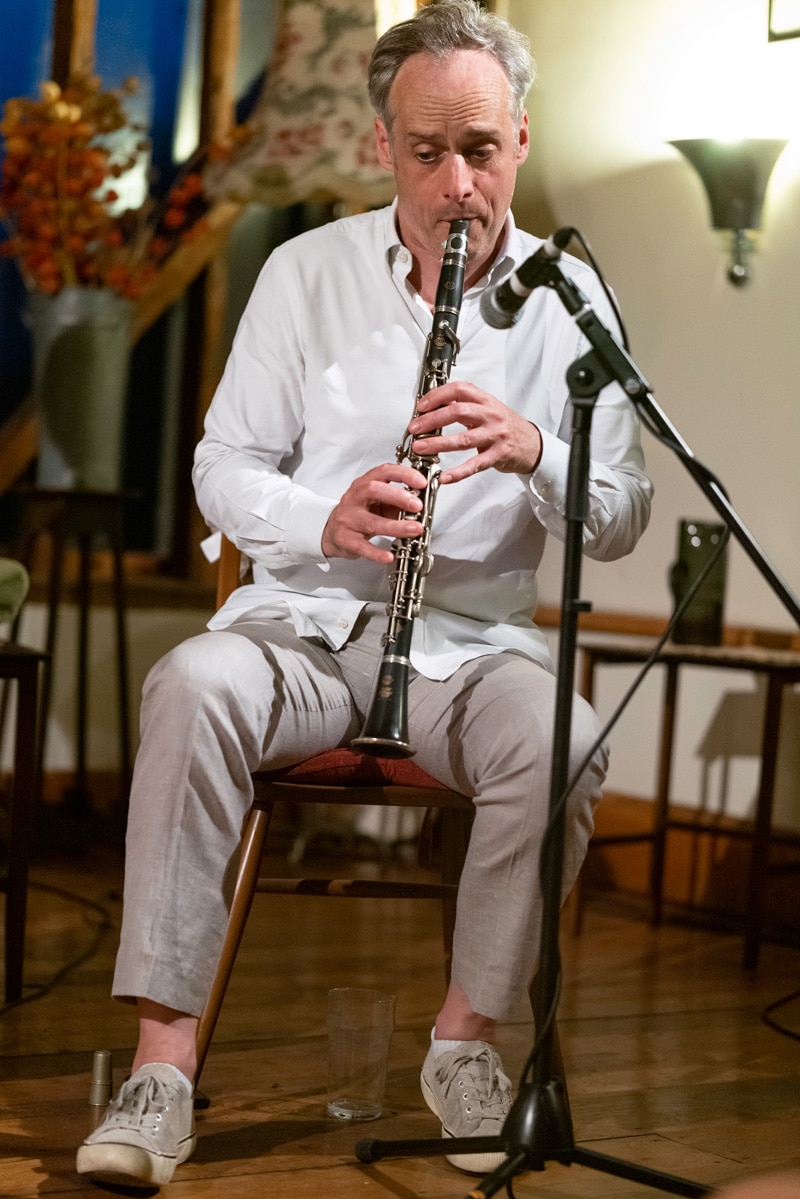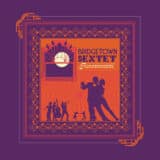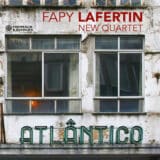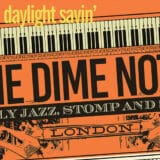Don Vappie & Jazz Creole
Award winning Créole Banjoist guitarist vocalist, considered one of the best banjoists in the history of New Orleans and credited with preserving Créole culture.
JAZZ ALBUM OF THE YEAR 2020 – THE TIMES UK
BEST OF THE BEAT NOMINATION 2020 – OFFBEAT USA
JAZZ IN MARCIAC 2022
STEVE MARTIN BANJO PRIZE 2021
AMERICAN BANJO HALL OF FAME 2022
Don Vappie is a Creole banjo player/singer from New Orleans. Awarded multiple times, he is recognised throughout the world as THE contemporary representative of a long line of illustrious musicians, such as Danny Barker and Johnny St Cyr. By honouring the traditions of his elders, Don in turn takes up the torch of the rich Creole musical history. He is an emblematic artist of his city, of his culture and today he is the headliner of many festivals and concert halls around the world.
He embodies the melting pot of New Orleans combining all genres of from traditional to modern day funk with the classic early tradition of a string band, and presents us with David Horniblow (UK), Dave Kelbie (UK) and Sebastien Girardot (FR) a quartet seasoned with Jelly Roll-like rhythms and garnished with traditional songs but also with original compositions.
DON VAPPIE – Banjo/voice
DAVID HORNIBLOW – Clarinet
DAVE KELBIE – Guitar
SÉBASTIEN GIRARDOT – Double Bass
“What’s exciting about this project is that we get to explore the music as it evolved in the Crescent city through the medium of the string band and the roles that our instruments played in the music. The very first bands of New Orleans were string bands. From the beginning strings played a big part in New Orleans music. The banjo was a staple of the rhythmic pulse in early jazz just as the the guitar spoke the language of the blues. The string bass took over from the tuba and by mixing 2/4 grooves with 4/4 grooves created a smooth pathway to the R&B shuffle. Interestingly, the bass lines of modern-day New Orleans R&B and Funk are reminiscent of the melodic unifying role played by the African predecessor to the banjo, the ngoni.
Our journey is to explore the widest range of possibilities our instruments can offer through a nontraditional approach within the tradition of Créole songs, R&B, New Orleans funk, second line and all that New Orleans has inspired around the world. After all, it was James Brown who said, “every instrument is playing the drums”. And this beat will go on.”
TRACKLISTS & RECORDINGS
PRESS
IGGY POP
JAZZ DIXIE | SWING FR
VINTAGE JAZZ MART UK
NEGOCIOS PORTUGAL
THE OBSERVER UK
JAZZ DA GAMA CANADA
SONGLINES UK
JAZZ HOT FR
CLARE TEAL, BBC
THE TIMES UK
LA GAZZETTE BLEUE FR
BEBOP SPOKEN HERE UK
THE TIMES PICAYUNE US
AMERICAN RECORD GUIDE US
No Events
VISIT https://www.donvappie.com
REVIEWS
ALBUM REVIEW. JAZZ DIXIE | SWING FR 01.08.2020
The Blue Book of Storyville by Don Vappie and Jazz Creole
According to the British Encyclopedia, the banjo is the only instrument used in Western music to combine skin and strings, hence a supposed cousinhood with African instruments. It would have been invented or reinvented by victims of the slave trade in North America… Anyway, it was first associated with black culture and music, before being adopted by popular music white people. With four, five or six strings, tuned in tenor, plectrum, guitar or alto (Irish tuning), or according to personal recipes, this instrument both rhythmic and melodic enjoyed from the end of the 19th century a considerable vogue, in particular in the ‘Minstrel Shows’, played by ‘blacked up’ whites.
This popularity continued at the turn of the 20th century, when it became the instrument of popular American music and radiated throughout the Western world and beyond. In the United States many Ragtimes were written for the banjo. It was also, between 1920 and 1930, a stylistically inseparable instrument in New Orleans music, from King Oliver to Louis Armstrong’s Hot Seven, as well as in the great orchestras of Fletcher Henderson or Duke Ellington. It was played by many virtuoso soloists, the most famous was Fred Van Eps, and known in the New Orleans style of eminent specialists like Johnny St Cyr, Bud Scott or Lee Blair to name a few. It then enjoyed a long eclipse on the jazz scene with the ‘mainstream’ style and the swing era which preferred the guitar. But it continued his journey in popular music: Blue Grass in the United States, ‘musette’ in France etc … (let’s not forget that Django Reinhardt made his debut on the banjo), and even repertory music was played in orchestras of banjos. Ignored, or despised, and even mocked by jazz musicians of the 1930s, it reappeared with the ‘revival’ of the late 1930s / early 1940s with white orchestras like those of Lu Watters, Turk Murphy, and then the Firehouse 5 + 2, as well as groups from New Orleans like that of clarinetist George Lewis who influenced the whole British revival, with Ken Colyer, Christ Barber, etc …
The greatest black ‘revivalists’, on the other hand, like Bechet or Ory, continued to ignore it. The ‘middle jazz’ had been there. You can find it in most ‘Dixieland’ orchestras today, but you still sometimes hear “it would still have been better with a guitar”. This remark, in fact, is addressed more to the instrumentalist than to the instrument, because the banjo supposed to be ‘easy’ by some (while there are no more easy instruments than ‘easy’ languages) is sometimes played ‘a minima’ by ‘banjo-washboard’ practitioners who are satisfied with a metronomic style without letting the tone develop. But played with flexibility by a musician who loves the instrument and is truly interested in its possibilities, the banjo is in no way inferior to its cousin.
Still, it is a real pleasure to listen to a musician like Don Vappie who gives the banjo its true musical richness and all the variety of its colours. It’s interesting – and heart-warming – how Don came to play – and so well – the banjo. Because, born in 1956, he was not originally drawn to New Orleans jazz. Certainly, born ‘uptown’ in a family where music played a big role, he knew in his childhood the music of parades and then of clubs. At six he took piano lessons, and by eight he played the trumpet, then the brass, in his school orchestra. In high school he switched to guitar and bass to play modern jazz and later practiced popular music, funk and disco.
It was drummer Cie Frazier who encouraged him to get back to basics, and that’s when he took to the banjo. This CD is dedicated to Louisiana Creole music and particularly New Orleans, with classics like Panama, Tin Roof Blues, Buddy Bolden Blues, Basin Street Blues and specifically Creole themes (Eh là bas, etc …), many between them sung in English or Creole by Don who has a beautiful voice particularly highlighted in his remarkable version of Buddy Bolden Blues.
The themes illustrate the richness and variety of the Creole heritage: La Ville Jacmel is a traditional Haitian song, Abandon is a composition by a Matiniquan author and is reminiscent of certain Cuban melodies. As for The Onions, the performance is much closer to the recording by clarinetist Albert Nicholas with Danny Barker on the banjo, dating from 1947, than to the later version made famous by Sidney Bechet. Albert Nicholas was not very happy with the way Sidney Bechet had appropriated this traditional theme.
Fais Dodo, presented here as a Creole lullaby – which is correct since this is how it is sung, with lyrics in Creole – is none other than the traditional French lullaby. There, Mo pas laimé çà and C’est l’Autre Cancan (recorded in 1944 by Kid Ory) are part of the traditional Creole repertoire.
Throughout these recordings, Don Vappie shows us all the musical palette that the banjo can offer. Whether he alternates playing by note, picking or chords, as in his two successive choruses on the fourth theme of Panama, he demonstrates a sure taste and a remarkable technique, which he does not abuse, but which is reflected in certain features. The sound is rich, the phrasing varied and the soft sway is enchanting.
Let us mention the excellent work of English clarinetist David Horniblow whose loose style fits perfectly with the idiom. We won’t hold it against him for one or two slightly shrill notes in the treble as his overall performance is convincing. As for Dave Kelbie (guitar) and Sébastien Girardot, these two remarkable well-known rhythmicians, the flexibility, the variety, the swing and the solidity of their accompaniment – I would rather say of their contribution – are a real treat. Listen to them in particular in Buddy Bolden Blues, whose version is worthy of that of Morton.
MICHEL MARCHETEAU
ALBUM REVIEW. VINTAGE JAZZ MART 01.07.2020
The Blue Book of Storyville by Don Vappie and Jazz Creole
I first encountered Don Vappie at the 2016 French Quarter Jazz Festival in New Orleans, in the plush surroundings of the Hotel Royal. He was playing modern jazz guitar duets with Steve Masakowski, and very fine they were too. Then, out of nowhere, he produced a banjo and gave us something quite other: a series of Cajun solos, music that was very new to me. Three years later, I caught up with him again: he was on stage in Jackson Square with his regular band, the ‘Créole Serenaders’, and explaining between numbers his determination to rehabilitate the banjo, bring it out of the obscurity of the rhythm section and let it shine as a front-line solo voice. And that is precisely what he does on this CD, recorded in London with David Horniblow on clarinet, Dave Kelbie, guitar and Sébastien Girardot on bass.
Vappie is a Créole, his family has been in New Orleans since before the Louisiana Purchase and his dedication to jazz from that city is not only in playing it: he teaches guitar at Loyola University and has worked on many other educational programmes, from the Lincoln Center in New York via Carnegie Hall to the Smithsonian Appalachian State University. He has performed with Peggy Lee, Eric Clapton, Diana Krall and many more; he has played French West African and Caribbean music, funk, soul and modern jazz…but has for some time now focused on his New Orleans roots: the banjo, then, is in expert hands.
The music on this CD is as varied as you’d expect from a New Orleans master: traditional Creole melodies, tunes by local composers (Morton, Ory, the ‘New Orleans Rhythm Kings’), and many compositions of his own. You may imagine from a quick scan of some titles (Eh la Bas, Mo Pas Laimé Ça, Les Oignons) that the music will be routine, hackneyed even. Not so, never so: Don Vappie is a true original and every tune is infused with a fire and inspiration that makes it a virtuoso performance. And his own compositions are a tribute to the Crescent City’s tricentenary: playing banjo, he says, ‘in a more melodic role, as I perceived it was in some of the Caribbean and African styles.’
The CD kicks off with what, in other musicians’ hands, might be just another version of a very old friend, Eh la bas, but Vappie’s coruscating habañera banjo rhythms and cross-rhythms with Girardot’s bass make this as exciting and original a performance as you could wish – with a finely crafted banjo solo to add just that little extra something, and played at less than the headlong pace of many other recordings. The title track The Blue Book of Storyville is one of Don Vappie’s originals, played with a stately swing and featuring one of his lovely vocals and some soaring – and searing – clarinet from David Horniblow.
The Blue Book, of course, was the notorious directory of Storyville ‘sporting houses’, and I can easily imagine Vappie’s music being played alongside the older songs in Mahogany Hall! Older songs like Buddy Bolden’s Blues, which opens with a lengthy banjo cadenza, before swinging into a beautifully relaxed performance, with some excellent clarinet ‘fills’ in the vocal choruses and ending with a virtuoso banjo coda. La Ville Jacmel is another Creole song, from Haiti, whilst the better-known Mo Pas Laimé Ça is New Orleans born bred. Both are played with the jaunty habañera rhythm so beloved of Jelly-Roll Morton; then the second song breaks into a straight 4/4 beat for a fine clarinet finale. Port Bayou St John is a Vappie original, named from the town on St Lucia and is in a quite different mode, based on a rock idea, according to Vappie himself and played with the Cuban-style ‘tresillo’ rhythm; whilst Couleur de Créole, also composed by Vappie, features a long, flowing clarinet line, which he says is based on an early New Orleans form that appears in, for example the main chorus of Alphonse Picou’s High Society. Playing in a small group like this allows Vappie to make the banjo a genuine melody instrument: he plays with a fluency and precision that is quite stunning…and nowhere better than on Basin Street Blues: the melody lead has some lovely variations and the vocal very effectively plays rubato with the chordal base at several points.
I Would If I Could is the last of Don Vappie’s own compositions; it’s an upbeat, happy-go-lucky tune, played in 4/4 time with a great swing and contrasts very effectively with the next track, Abandon, a haunting melody in waltz-time, from Martinique. The banjo is a masterpiece of clean picking and clever trills, and there’s great fluid clarinet from Horniblow. C’est l’autre Cancan refers not to a dance (Creole or otherwise) but to a gossipy woman, though Jelly-Roll Morton suggests the word is much more vulgar than that. The tune is credited to Kid Ory, though is obviously much older than his 1944 recording of it. Red Wing and Misu Banjo are both traditional tunes: the former has a long pedigree of performance by folk and jazz musicians alike, but few of the latter have made it swing like this group. Tin Roof Blues and the traditional Créole Blues are played as a medley, introduced once again with a lovely unaccompanied banjo solo; Horniblow’s clarinet is both passionate and reflective by turns on the first title, while Vappie sings a fine Creole-French vocal on the second, wrapped by the riff chorus from Tin Roof as a ride-out. Panama is the old standard, but played here with an habañera rhythm in the opening and third strains, as it was apparently intended when written in 1912. It’s taken at a much more relaxed tempo than many versions, which allows David Horniblow to give full emphasis to melody in the final strain. The CD closes with two more traditional Creole numbers, Les Oignons and Fais Do Do: Don Vappie sings both in Créole patois and turns in a lengthy and punching solo on the former; the second title is a lullaby played in 3/4 time and is a delightful solo vocal and banjo performance.
Seeing Don Vappie on stage is an experience in so many ways, not least his ability to convey passion, humour and that special musicianly spark that makes his performances so exciting. This CD is beautifully recorded and although I haven’t said much about them till now, I must mention the fine guitar backing provided by Dave Kelbie and bass lines from Australian Sébastien Girardot. These four musicians form a tightly-knit ensemble, which is perfect for Don Vappie’s material and makes it as good as anything I’ve heard from him ‘live’. This is a terrific CD.
MAX EASTERMAN
ALBUM REVIEW. SYNCOPATED TIMES 01.07.2020
The Blue Book of Storyville by Don Vappie and Jazz Creole
Don Vappie, who is interviewed in this issue, has had a long career for a man of 64. He drifted into traditional jazz from other styles of New Orleans music and by the ’80s was recording as a leader and playing in Europe with Dr. Michael White. In the spring of 2005 he made a decision to forge his own musical path and leave behind a comfortable seat at Preservation Hall. Several months before Hurricane Katrina became everyone in New Orleans’ before and after, he had his own.
That year he produced two great albums, one with his Creole Serenaders and the other a solo effort, Banjo a la Creole, which investigated jelly Roll Morton and the Caribbean influence, it could be said to presage, his current release, The Blue Book of Storyville.
After the storm his return to his native city was the subject of a documentary, American Creole: New Orleans Reunion, which followed him as he explored the wreckage and pondered the future. Vappie is an exceptional ponderer, as anyone who has joined him for his recent “coffee on the porch” live stream sessions will attest. He’s also proven himself an exceptional investigator. He has pursued his interest in the banjo over time and space, as far as Africa, and played with contemporary professionals from the continent.
In 2008 he was part of a four man crew on an album titled Recapturing Banjo which sought to dignify and promote the banjo as an African American instrument. That idea, giving banjo pride of place, is a theme of Don Vappie’s career that rings out clearly on this album. He doesn’t see the instrument the way many people of color of his generation did and seeks to demonstrate that it embodies more than what it has been assigned, that it contains multitudes.
The banjo is often confined in traditional jazz to a rhythmic role. Vappie emphasizes instead the instrument’s melodic potential and ability to speak. Inexperienced banjoists who attempt this often fall back on a bluegrass phrasings but Vappie harnesses the jazz tradition of Danny Barker and Johnny St. Cyr. The 1946/7 sessions of banjoist Danny Barker, and clarinetist Albert Nicholas were particularly influential to his vision of the role banjo should play.
Given that inspiration he is well matched on this album by clarinetist David Horniblow. They lead a tight quartet allowing their instruments to engage on refreshingly equal terms as they explore material both revelatory and well suited to this dynamic group. Rhythm is taken up by Sebastien Girardot on bass and Dave Kelbie on guitar. Both were founding members, with Evan Christopher, of Django a la Creole, a successful project uniting New Orleans origins with the European gypsy jazz legacy. Kelbie also produces Bluebook which is released on his leiazzetal label.
This instrumentation parallels an often forgotten string band tradition within New Orleans. String instruments dominated parlors and quieter settings for both the wealthy and downtrodden. String instruments were more affordable on the whole, and easier to make yourself, giving rise to the spasm bands found on New Orleans streets when French speaking Kid Ory first arrived in the city from Woodland Plantation at the turn of the century. Ory was a creole, like Vappie, and his first instrument, before adopting the trombone, had been a banjo.
To understand Blue Book of Storyville, and Don Vappie’s vision generally, you need to understand what he means by Creole, the ethnic heritage by which he identifies. “What I call Creole are New Orleans people who aren’t white and aren’t black. We’re a mix of French, Spanish, African and American Indian, and that mixture made this city what it is.” He freely draws on these Creole and Caribbean banjo cultures in his vision for the instrument.
Blue Book began as a cycle of original compositions intended to tell the three hundred year story of New Orleans. The title track, “The Blue Book of Storyville” is one of these. I found it jarring at first, but that, I discovered, may have been his intent; to call out the moral ambiguities in a place often celebrated in the history of jazz. Vappie finds his more important influences outside of “The District”, in his own creole heritage. The meeting of
musical cultures in a port city.
Other Vappie originals bare witness to places like the Indian village at Bayou St. John that existed before white settlement, and the local tradition of community dances in which Vappie got his start back in the 70s. “Couleur de Creole” is an instrumental that Vappie says draws on a musical construction common in early New Orleans playing that bares a similarity to a style from Brazil. It takes no imagination to hear that connection and the track is my favorite of Vappie’s compositions here.
The balance of the nearly 70 minute, 17 track album consists of classics like “Basin Street Blues”, “Red Wing” and “Panama”, and traditionals like “La Ville Jacmel”, a Haitian song, and “Abandon”, from Martinique. “Eh la Bas” and “Moi Pas L’aime Ca” bring it back to the Crescent City creole jazz culture. Several give Vappie the opportunity to sing in Creole French and he does so engagingly. In a nod to Kid Ory’s roots he sings “C’est L’autre Cancan” also known as “Creole Song” which Ory recorded in 1944.
Through it all there is a uniting theme, the love of a gumbo city steeped in history. I first listened to this album on headphones as I shoveled snow last winter. I’ve recently enjoyed it with good company and barbecue on a humid June day. You can guess which environment best brought out the nuances. The word barbecue, by the way, is itself a Caribbean heritage.
This accessible album will be enjoyed by all, and should, I hope, bring Don Vappie and the fine musicians who join him attention far outside of our jazz enclave. You don’t need to “get it” to sit back and enjoy it. But reading the fine liner notes from lejazzetal and really tuning in to the musical exchanges and rhythms will reward repeated listening. An album can be both successful and good.
JOE BEBCO
ALBUM REVIEW. NECOCIOS PORTUGAL 22.05.2020
O belo som do banjo
Desde já aviso que só vale a pena continuar a ler estas linhas se gostar das sonoridades crioulas de Nova Orleães e de banjo. Eu gosto, de maneira que me deliciei com “The Blue Book Of Storyville”, de Don Vappie, personagem exuberante, exímio tocador de banjo, vocalista cheio de tiques locais, ao lado dos Jazz Creóle, um trio constituído para esta ocasião e que integra nomes como Dave Kelbie, na guitarra (e produção), Sebastien Girardot, no baixo, e David Horniblow, no clarinete. Cabe aqui recordar que a tradição musical de Nova Orleães está ligada ao nascimento e crescimento do jazz. Neste disco, estão canções crioulas originais (algumas no tradicional francês da região), standards de jazz e alguns originais do próprio Vappie, cuja educação musical vem aliás do jazz – começou pela guitarra e pelo baixo, e só depois se dedicou ao banjo, muito influenciado por um dos grandes músicos dos anos 40 de Danny Baker, um dos históricos tocadores de banjo e contadores de canções de Nova Orleães. Don Vappie pesquisou para este disco a música cajun, inspirações do Caribe, canções tradicionais, temas popularizados por Louis Armstrong ou Sidney Bechet, por exemplo. É difícil destacar um tema, de entre os 17 deste disco, mas o meu preferido é “Buddy Bolden’s Blues”. Vappie mostra bem a importância do banjo na música de Nova Orleães e a sua relevância, muitas vezes esquecida, no jazz.
The beautiful sound of the banjo
I already warn you that it is only worth continuing to read these lines if you like the Creole sounds of New Orleans and banjo. I like, in a way that I was delighted with “The Blue Book Of Storyville”, by Don Vappie, exuberant character, excellent banjo player, vocalist full of local tics, alongside Jazz Creóle, a trio formed for this occasion and that integrates names like Dave Kelbie, on guitar (and production), Sebastien Girardot, on bass, and David Horniblow, on clarinet. It is worth remembering that the musical tradition of New Orleans is linked to the birth and growth of jazz. On this album, there are original Creole songs (some in the traditional French of the region), jazz standards and some originals by Vappie himself, whose musical education comes from jazz – he started with the guitar and bass, and only later dedicated himself to the banjo, very influenced by one of the great 1940s musicians Danny Barker, also one of New Orleans’s historic banjo players and songsters. Don Vappie researched Cajun music, Caribbean inspirations, traditional songs, themes popularized by Louis Armstrong or Sidney Bechet, for example. It is difficult to highlight a theme, among the 17 of this album, but my favorite is “Buddy Bolden’s Blues”. Vappie shows the importance of the banjo in New Orleans music and its often overlooked relevance in jazz.
MANUEL FALCAO
ALBUM REVIEW. THE OBSERVER UK 15.05.2020
Don Vappie & Jazz Créole: The Blue Book of Storyville
An easy-going singer, virtuoso of the banjo and larger-than life character, Don Vappie is as New Orleans as they come. His mixed-race Creole ancestors were living in the city before Napoleon sold it to the US in 1803. A century later, Creoles, still speaking their own version of French, accounted for many of the city’s early jazz musicians, and Vappie (originally Vapaille) is making sure nobody forgets any of it. Not that they’d want to after experiencing this lively collection of traditional Creole songs, old jazz standards and Vappie originals.
To begin with there’s that inimitable New Orleans rhythm. It’s not always the same pattern, but it has what Jelly Roll Morton (another Creole) called the “Spanish tinge”. With no percussion, there’s a delicacy about it here too. There are just three in the accompanying band: Dave Kelbie (guitar), Sébastien Girardot (bass) and David Horniblow (clarinet), whose bright tone and fluid style make him a perfect partner for Vappie. Their duet playing in the instrumental numbers, such as Couleur de Creole, is simply brilliant. And it’s about time someone showed the jazz world what the banjo really can do.
DAVE GELLY
ALBUM REVIEW. OFFBEAT MAGAZINE US 28.04.2020
Don Vappie & Jazz Créole: The Blue Book of Storyville
Don Vappie is one of the best practitioners of traditional Creole banjo playing and his mind holds a vast repository of information about the history, the songs and the traditions of Créole culture across the vast diaspora. On his new album, The Blue Book of Storyville, Vappie distills everything he has learned into a 17-song collection that features well-known traditional jazz tunes, obscure titles, traditional Créole songs from the Caribbean and three outstanding originals.
The album opens with “Eh La Bas,” a call-and-response favorite popularized by Danny Barker. From the first strummed chords on his banjo, followed by the stellar clarinet work of David Horniblow, the steady rhythm guitar of Dave Kelbie (he also produced the album) and the double bass of Sebastien Giradot, the listener immediately knows Vappie has a winning album on his hands.
Despite so much focus on the musicology associated with traditional musical forms, this music is inherently joyful. You can hear it in Vappie’s singing voice especially when he is singing in French; you can hear it in the exuberance of the clarinet and in the trilling banjo solos and crisp lead lines that populate the album.
The songs from the Caribbean are some of the highlights of the album. The title of “La Ville Jacmel” name checks the southern Haitian city whose architecture of wrought iron influenced the world-famous style of the French Quarter. Vappie takes a stunning solo on the cut.
“Abandon,” an instrumental ballad from Martinique, opens with Horniblow’s clarinet in its mournful lower register. As the song progresses, Vappie plays an intricate single note solo that merges organically when the clarinet enters again.
This album is one you can listen to over and over and if you so choose; delve into the extensive liner notes for even more enrichment.
JAY MAZZA
ALBUM REVIEW. JAZZ JOURNAL 06.04.2020
Don Vappie & Jazz Créole: The Blue Book of Storyville
Raised in uptown New Orleans, in a musical family of creole origins, Vappie initially played bass and guitar in modern jazz groups, and in hotel big bands performing popular music of the day. Subsequently, he took up the banjo, working on the riverboat Natchez. He developed a keen interest in the historic contributions of the banjo, and of native creole songs, to the early development of New Orleans jazz.
A major aim of his is to extend the banjo’s customary back-line supportive role in traditional jazz into more melodically prominent activity. Vappie was particularly influenced by the 1946/7 recordings of famed creole banjoist, vocalist and raconteur Danny Baker, with clarinettist Albert Nicholas.
Technically adept and assured in various rhythmic styles, Vappie’s plangent and percussive single-string picking and neat chord fills establish a clear-cut melodic line. This is reinforced enjoyably, alongside free ensemble soloing, by well-executed harmonised or unison rapport, phrasing with Horniblow’s responsive and expressive clarinet.
Becoming something of a champion for creole culture in general, Vappie has selected here examples of Caribbean, cajun, French and Spanish traditional songs which were early basic ingredients in the great musical melting pot of cosmopolitan New Orleans music. Jazz standards associated with Kid Ory, (who started on banjo), Morton, Armstrong, Bechet and Nicholas rub shoulders with Vappie’s own interesting and creole-themed originals plus some old folk songs. His stylised spirited vocals, in English and creole French, dominate most tracks, and add enjoyable colour and interest. Buddy Bolden’s Blues is particularly well done.
In support, Vappie could not have bettered his three sidesmen. Kelbie (the record’s producer) and Giradot had previously impressed me with their fine playing in recordings by the Django A La Créole group, and David Horniblow’s vibrant and creative clarinet artistry impresses here, as in the Dime Notes album. Vappie, certainly a doyen in his specialist field, deserves much credit for his reaffirmation of the important part the banjo can still play in jazz ensemble, and of its distinguished past stretching back to Johnny St Cyr and long before.
HUGH RAINEY
ALBUM REVIEW. SONGLINES MAGAZINE UK 04.04.2020
Don Vappie & Jazz Créole: The Blue Book of Storyville
Don Vappie is one of the world’s preeminent banjoists and an out and proud New Orleans Creole (of French and African ancestry). Vappie’s roots are in New Orleans jazz but his questing nature has seen him seek out West African string players (Cheick Hamala Diabate, Bassekou Kouyate) alongside blues, Caribbean and other genres.
On this fine album Vappie leads a band featuring double bass, acoustic guitar, saxophone and clarinet. The music they make is rooted in the jazz that was created in New Orleans a century ago and they use it to explore what Vappie calls a ‘Creole vibe.’ Thus things vary from ‘Buddy Bolden’s Blues’ – a jazz standard – through the traditional Haitian song ‘La Ville Jacmel’ to the celebration of St Lucia ‘Port Bayou St John’ and ‘Abandon’, a composition by the late Martiniquais composer Loulou Boislaville. Across the album the ensemble play with ease and imagination, with Vappie singing on certain numbers. The acoustic instruments allow lots of space so that the music really breathes. Was this how the port of New Orleans sounded a century ago as musicians from across the Caribbean arrived and meshed?
Music that’s languid and lively and Creole in character.
GARTH CARTWRIGHT
ALBUM REVIEW. JUST JAZZ UK 01.04.2020
Don Vappie & Jazz Créole: The Blue Book of Storyville
Don Vappie is considered as one of New Orleans best banjo players on the present New Orleans music scene. Although not one of the younger generation musicians, having been born in 1956, he is part of the what is/was known as the new generation of New Orleans jazz musicians, Dr. Michael White, Greg Stafford, Detroit Brooks, Freddie Lonzo etc.
He was born into a musical family. His great uncle was bassist Papa John Joseph and his grandmother Stella Joseph Walker played banjo and guitar, but Don didn’t immediately find jazz or the banjo as his passion. He played bass and guitar in Modern jazz ensembles and worked in popular music, hotel Big Bands, Funk and Disco, which led to frustration as sound systems and DJs replaced live music.
Don was urged by drummer Cie Frazier to explore New Orleans jazz. While working in a music store he decided to try playing the banjo, finding that if he used guitar tuning, he could adapt quite easily. Don used to take the banjo along to gigs, ending up getting a steady gig on the riverboat Natchez. The rest is now history. He now happily plays his banjo (along with his guitar and six-string banjo) on gigs in New Orleans and at festivals around the world.
On this CD, Don is happily at home in a small band situation playing a selection of tunes close to his heart, many of them old Creole tunes. He is joined by three very accomplished jazz musicians: clarinettist Dave Horniblow of Vitality Five/Dime Notes fame, who plays excellently, and on listening to this CD could be mistaken for a ‘New Orleans hometown boy’; added to that, we have support from the great rhythm guitar of Dave Kelbie and some ‘lay-it-down’ bass playing from Sebastien Girardot. In fact, if you close your eyes and listen, you would be mistaken if you thought this was recorded in New Orleans by four ‘home-grown’ musicians. A credit to them all. I’m sure that Dave Kelbie and Sebastien Girardot have absorbed many of their New Orleans ambiences from their long association with clarinettist Evan Christopher.
The CD booklet is excellently written by Nick Spitzer of Tulane University and contains small biographies of the musicians as well as information about the tunes. This is a well recorded, well executed CD, well worth the attention of New Orleans jazz fans. I can recommend purchase. It is available from Dave Kelbie at Lejazzetal Records by email: – dave.kelbie@gmail.com or from their website: – www.lejazzetal.com
PETE LAY
ALBUM REVIEW. JAZZ DA GAMA C 23.03.2020
Don Vappie & Jazz Créole: The Blue Book of Storyville
History is recorded in the bones of men and women who are long since ghosts of our past. But the cultural topography upon which they have treaded can be kept alive if we can be still and listen to the stories that have been somehow, shaken and set free to roam in the wind. These are the stories of griots – ancient and modern – who heard things from the songs and stories told and sung by their ancestors. Much of this is lost, today, in the noise of everyday life, but not in New Orleans…. Still, the griots sing… the jazz griots… they sing their stories and their poems… vocally and instrumentally they make and pass on history, just like Danny Barker did not long ago and just like Don Vappie does today – spreading the gospel of music from a pulpit somewhere in New Orleans.
Mr Vappie is one of the great créolité griots of New Orleans. He embodies the quality of being Créole the highest degree just as Monk Boudreaux does. And like Monk Boudreaux he is fervent evangelist all things créolité. Mr Vappie sets stages aflame wherever he goes and he is just as magnificent on record as well. The Blue Book of Storyville is one such recording. The 17-strong, hour and almost ten-minute-long recording is brimful of masterfully delivered narratives – many of which he sings in his gloriously-cultured and highly-emotive tenor, always accompanied by his effervescent banjo. The brainchild of this performance – or at least the one who masterminded its production is the English musician, archivist and entrepreneur who just so happens to also be an ethnomusicologist and dyed-in-the-wool disciple of the Jazz tradition – whether its source is manouche or – in this case – créolité.
The repertoire is a judicious mix of originals by Mr Vappie, Jelly Roll Morton, Kid Ory, Spencer Williams and traditional music that receives Mr Vappie’s unique treatment and interpretation. Mr Vappie is a born storyteller – an urban griot, who has lived the music and has consigned all of it to the centre of his being. Each of the songs speaks to him in a highly personal manner in the epicentre of his heart from where – and with which rhythm – it is released through his lips. He is a vocal artist of the first order. His instrument is lustrous, bathed in warmth and radiantly burnished. His phrases are eloquently delivered. He sings and recites the lyric like a gentleman of extraordinary créolité nobility, accompanying himself on the banjo with unblemished virtuosity. Each and every work constitutes a new benchmark version. “Eh la Bas”, “Buddy Bolden’s Blues”, “Mischieu Banjo”, “The Roof Blues” and “Fais Dodo” are particularly unforgettable.
Mr Vappie is joined here by wonderful musicians. Mr Kelbie keeps perfect time (sometimes almost too unobtrusively) on acoustic guitar, Sébastien Giradot anchors the bass line melody and clarinetist David Horniblow soars in perfectly sculpted arcs and parabolas, often soloing in response to Mr Vappie’s voice and banjo. The best part of the performance of these musicians is that each is perfectly attuned to Mr Vappie’s vision and artistry as well as to the subtle rhythm and narrative of New Orleans créolité music. This music is also captured with an extraordinary warm acoustic. Music and engineering, indeed the whole package speaks of what historic masterpieces are made of.
Track list – 1: Eh la Bas; 2: The Blue Book of Storyville; 3: Buddy Bolden’s Blues; 4: La Ville Jacamel; 5: Port Bayou St John; 6: Mo pas laimé ca; 7: Couleur de Creole; 8: Basin Street Blues; 9: I Would if I Could; 10: Abandon; 11: C’est l’autre Cancan; 12: Red Wing; 13: Mischieu Banjo; 14: Tin Roof Blues – Créole Blues; 15: Panama; 16: Les Oignons; 17: Fais Dodo
Personnel – Don Vappie: banjo and vocals; David Horniblow: clarinet; Dave Kelbie: guitar; Sébastien Giradot: contrabass
RAUL DA GAMA
ALBUM REVIEW. JAZZ HOT FR 29.02.2020
Don Vappie & Jazz Créole – The Blue Book of Storyville
Don Vappie n’est plus à présenter tant comme artiste-musicien néo-orléanais que comme activiste de la cause créole. Il a déjà de nombreux disques de qualité à son actif. Celui-ci a été réalisé à Londres pour le label du guitariste Dave Kelbie qui s’est aussi consacré à Fapy Lafertin-Evan Christopher (A Summit in Paris) et au clarinettiste David Horniblow (The Complete Morton Project). Les titres originaux sont des compositions de Don Vappie, intelligemment intégrés à un programme de standards traditionnels louisianais comme «Eh la bas» qui débute le disque et que firent connaître Kid Ory, DeDe Pierce et Danny Barker entre autres. Il rappelle d’emblée que Don Vappie n’est pas seulement un solide banjo virtuose mais qu’il est aussi un chanteur délicieux. La clarinette de David Horniblow se marie bien avec un discours simple servi par une bonne sonorité. «The Blue Book of Storyville» composé par Vappie est lancé par la contrebasse toute en rondeurs de Sébastien Girardot, rejointe par la clarinette plaintive puis le chant du blues (en anglais) de l’auteur. Le Blue Book était le catalogue des charmes proposés par le quartier chaud de New Orleans, Storyville, dont le rôle dans la genèse du jazz a été amplifié. Les jazzfans sont des romantiques et ils préfèrent souvent les histoires à l’Histoire. En tout cas, nous avons là une bonne interprétation. Le fier et très talentueux créole Jelly Roll Morton a lui aussi contribué aux rêves notamment en alimentant la pure légende de Buddy Bolden. Nous trouvons donc ici l’incontournable «Buddy Bolden Blues» admirablement chanté par Don Vappie et agrémenté des inflexions bien venues de David Horniblow. Kelbie et Girardot sont aussi discrets qu’efficaces. La «touche latine» chère à Morton mais dont il n’a pas exagéré l’usage, surgit ici dès «La Ville Jacmel» chanté en créole. Vappie a aussi composé «Port Bayou St John» (latin et très virtuose), «Couleur de Créole» (genre dansant mais pas simple pour la clarinette) et «I Would if I Could» (merveilleusement swing, avec un solo de Girardot en prime). L’album, on s’en doute, fait une large place à Haïti, au Brésil (Pixinguinha, idole de Thomas L’Etienne), à la Martinique (mélancolique «Abandon» de Loulou Boislaville). Horniblow est bien parti, comme on dit, dans «Tin Roof Blues/Créole Blues». Excellent slap de Girardot dans «Panama», et il prend un bon solo qui est juste la mélodie dans «Red Wing». Nous avons aussi une bonne version balancée de «Basin Street Blues» et de plaisantes reprises de «C’est l’autre cancan» qui fut enregistré par Kid Ory (1944) et des «Oignons» imposés en France par Sidney Bechet (dès 1949).
Le livret est soigné avec de belles photos, mais on est surpris de trouver le trompettiste Papa Celestin dans la liste des banjoïstes louisianais alors que n’y figurent pas Narvin Kimball, Lawrence Marrero, Papa French et Creole George Guesnon notamment. C’est histoire d’être taquin, car ce disque va ravir les enthousiastes de «créolités».
MICHEL LEPLACE
ALBUM REVIEW. LA GAZZETTE BLEUE FR 20.02.2020
Don Vappie & Jazz Créole – The Blue Book of Storyville
N’oublie jamais ceci : jouer du jazz, c’est comme raconter une histoire » : Est-ce que que Don Vappie avait un livre de Maxence Fermine dans ses bagages pendant l’enregistrement de ce nouveau disque ? Peut-être, ce qui est sûr, c’est que le musicien originaire de la Nouvelle-Orléans revient « The Blue Book of Storyville », un projet faisant honneur à ses origines créoles et au jazz traditionnel de la Louisiane.
Mélange de compositions originales et de standards du début du 20ème siècle rendant hommage à Spencer Williams, Jelly Roll Morton, Kerry Mills (entre autres), c’est un quartet ingénieux composé du grand Don Vappie au banjo et au chant, David Horniblow à la clarinette, Dave Kelbie à la guitare, et de Sébastien Girardot à la contrebasse, qui nous accompagne dans plusieurs ambiances grâce à une complémentarité remarquable. Tantôt ambiance nocturne sous fumée de cigarette dans un bar de Baton Rouge avec « Eh Là-Bas », tantôt rues de New York des années 40 avec « Buddy Bolden’s Blues », c’est un véritable voyage dans un temps révolu que nous offre ce disque à travers ses dix-sept morceaux. Des portes se présentent, et chacune d’entre elles nous permettent d’accéder à une nouvelle atmosphère, un nouvel environnement.
Véritable mélange de cultures, cet album est une ode aux sonorités d’ailleurs : on y chante français dans « Les Oignons », créole dans « Mo Pas Laimé ça », anglais dans « I Would if I Could », en découvrant un mélange de jazz, de swing, de blues, de sonorités sud-américaines. Une, deux, même trois ambiances peuvent se retrouver dans un morceau, à l’image de « Port Bayou St John », qui nous amène au fur et à mesure dans les contrées du Far West, puis au beau milieu d’un village aux sonorités latines grâce à la guitare du brillant Dave Kelbie.
Les mélodies sont variées et offrent un projet riche grâce à un quartet talentueux. Un son positif, une voix chaleureuse ajouté à des compositions entraînantes. Vous souhaitez voyager sans sortir de chez vous ? Don Vappie & Jazz Créole vous en donne l’occasion.
CORENTIN MARATRAT
ALBUM REVIEW. SYNCOPATED TIMES US 04.03.2020
Don Vappie & Jazz Créole – The Blue Book of Storyville
Don Vappie has had quite a career as a banjoist, guitarist, bassist, singer, arranger-composer, educator, lecturer, record and event producer, and expert about all aspects of New Orleans jazz. While he began playing music as an electric bassist in funk groups, he gradually moved towards the guitar and the banjo, playing traditional jazz with small groups and as a solo banjoist. He started recording in the mid-1980s, has worked with the Jazz At Lincoln Center Orchestra on and off since 1994, led the Creole Jazz Serenaders, and been an important spokesman on television specials and PBS about the music of New Orleans.
Listening to The Blue Book Of Storyville, it is easy to compare Don Vappie with the late Danny Barker, who was also an important banjoist, guitarist, educator and spokesman, but Vappie has his own sound as a banjoist and singer. For this project he is teamed with Jazz Créole, a trio consisting of clarinetist David Horniblow, rhythm guitarist Dave Kelbie, and bassist Sebastien Girardot. Kelbie and Girardot, both of whom played with Evan Christopher in Django a la Creole, give the two lead voices gentle but swinging support throughout.
Vappie sings songs in both French (“Eh La Bas,” “Les Oignons” and Kid Ory’s “C’est l’autre Cancan” among them) and English (“Buddy Bolden’s Blues,” “Basin Street Blues” and his own “The Blue Book Of Storyville”) and takes inventive banjo solos on the instrumentals including “Panama” and the obscure “Abandon.”
The interplay between Don Vappie’s voice and banjo with clarinetist David Horniblow is a joy on nearly every selection, and makes this CD a gem growing in interest with each listen.
SCOTT YANOW
ALBUM REVIEW. BEBOP SPOKEN HERE UK 28.01.2020
Don Vappie & Jazz Créole – The Blue Book of Storyville
Don Vappie (banjo, vocals); David Horniblow (clarinet); Dave Kelbie (guitar); Sébastien Girardot (double bass)
Don Vappie has amassed an impressive back catalogue of recordings as a bandleader and sideman. The Blue Book of Storyville on Dave Kelbie’s Lejazzetal Records is the banjoist’s latest as leader and he is in good company working with David Horniblow, clarinet, Lejazzetal label boss Dave Kelbie, guitar and Sébastien Girardot, double bass.
Seventeen tracks stretching over the best part of seventy minutes are band arrangements of familiar, some less familiar, numbers with a particular emphasis on Vappie’s Créole heritage. The vocals – in English and in French – are Vappie’s and his sunny disposition comes shining through. The Blue Book of Storyville (comp. D. Vappie) is an early highlight swiftly followed by Jelly Roll Morton’s Buddy Bolden’s Blues.
David Horniblow is well versed in the Crescent City style (Horniblow’s The Complete Morton Project duo album with pianist Andrew Oliver on Lejazzetal is recommended listening) and on this 2019 Vappie recording the London based clarinettist makes several incisive contributions.
It comes as little surprise to find New Orleans’ staples Basin Street Blues and Red Wing making the cut alongside Vappie’s own compositons. The Blue Book of Storyville (the title track) is Vappie’s critique of his home city’s red light district, its bawdy houses of a century ago and songs of the period which were rather disparaging of the women working on the upper floors as the ‘piano professors’ worked the bar room below.
The New Orleans Rhythm Kings’ Tin Roof Blues, sounding as good as ever almost a century on, is paired with Créole Blues, a tune, as Nick Spitzer points out in his informative sleeve notes, Vappie learned from the 1947 version recorded by Danny Barker and Albert Nicholas. The rhythm boys on this album – Dave Kelbie and Sébastien Girardot – know their onions (French or otherwise) when it comes to the repertoire and, tune after tune, lay down a solid foundation.
Lejazzetal’s reputation goes before it, this new Don Vappie album serves to reaffirm it. Recommended.
RUSSELL
ALBUM REVIEW. SUNDAY TIMES UK 12.01.2020
DON VAPPIE & JAZZ CREOLE. The Blue Book of Storyville
An authentic voice of New Orleans, Don Vappie is a banjo player immersed in the local Creole culture — you may well have heard him in the immaculate band Django à la Créole. This unabashedly laid-back set has songs and vamps that, in true Big Easy style, blend jazz virtuosity with buoyant blues riffs and a splash of Caribbean rhythms. The ghosts of Jelly Roll Morton, Sidney Bechet and Kid Ory roam the streets again.
CLIVE DAVIS
ALBUM REVIEW. ENTRE LES LIGNES ENTRE LES MOTS FR 03.02.2020
Jazz de la Nouvelle-Orléans. Les mémoires du banjo, mémoires du jazz
Don Vappie fait partie des musiciens produits par la Nouvelle Orléans. Un virtuose de l’instrument indispensable pour le jazz des origines : le banjo. « The Blue Book of Storyville » se veut mémoires de la musique des Créoles, croisement entre les maîtres blancs et français avec les esclaves issues de l’Afrique. Ils constituaient une sorte de classe moyenne dans la stratification de la société louisianaise entre les Blancs et les Noirs des quartiers déshérités de la Ville. Après la vente de la Louisiane par Napoléon, ce statut particulier sera aboli par les nouveaux maîtres. A leur grande colère, les Créoles seront assimilés aux Noirs.
Cet ancrage historique permet de comprendre l’utilisation du français – mâtiné certes, le créole est une langue singulière – dans les chansons qui sont reprises par Don Vappie et Jazz Créole, le nom du groupe : David Horniblow, clarinette, Dave Kelbie, guitare et Sébastien Girardot, contrebasse. Ils reprennent « Les Oignons » que Sidney Bechet avait signé alors qu’il s’agit d’une chanson traditionnelle de la Nouvelle Orléans.
Une musique vivante, dansante, drôle tout en étant pleine de mémoires qui transforme le passé en autant de feux-follets pour permettre de construire un avenir.
Fallait-il, pour autant, faire référence à Storyville, le quartier des bordels – un pour les Blancs et un pour les Noirs – fermé en 1917 ? Il faudrait faire taire la légende qui veut que le jazz soit né dans les lieux de plaisirs – pas pour tout le monde, le plaisir ! – alors qu’il a germé dans la rue, dans les ghettos.
NICOLAS BÉNIÈS
OFFBEAT MAGAZINE USA – 01.11.2008
Don Vappie: Give Me Back My Banjo
In 2007, the Folk Alliance hosted a concert by three banjo players at Memphis’s Marriott Hotel. The three men sat in a semi-circle of chairs, the drum-like bodies of the banjos in their laps, the thin sticks of their fretboards pointing to two o’clock. It was a historic occasion, for all three men were African-American, and they were previewing the music that would be released a year later as the landmark Recapturing the Banjo album.
The burly man with the squinting eyes, full beard and blue baseball cap was Colorado’s Otis Taylor, the man who had organized the project. The even larger man with the long dreadlocks spilling out of the green cap was Memphis’s Alvin Youngblood Hart, a Taj Mahal-like blues revivalist and rock ’n’ roller. The third man, the one with the thick curly hair, silver goatee and dapper black blazer was Don Vappie, a major figure from the New Orleans traditional jazz scene.
The three men were intent on “recapturing the banjo” because the instrument had become so closely associated with bluegrass that most people had forgotten that it was originally an African invention. They were unaware of the major role it had played in the music of American slaves and their descendants until the 1930s. These musicians wanted to remind everyone where the banjo had come from and what it had done for African-American music.
Taylor and Hart were most interested in the jug bands, string bands and blues singers from the upper South who made great recordings with the banjo in the ’20s and ’30s. They were trying to jump-start a tradition that had stalled, to retie a thread that had been broken, reconstructing a lost art from those records. When they closed the show with “Walk Right In” by Memphis jug-band giant Gus Cannon, the Carolina Chocolate Drops’ Dom Flemons joined in on backing vocals.
Vappie, by contrast, was trying to extend a banjo tradition that had never been broken. The banjo has been a constant presence in New Orleans jazz from the time Danny Barker played banjo with the Boozan Kings in 1923 until he played it with Wynton Marsalis in 1988. When Vappie played in Memphis, crooning the lilting Creole lyrics to “Les Ognons,” he was playing a music he’d learned from older New Orleans musicians, some of them his own relatives. And he played it on the four-string tenor banjo of his hometown, not on the more widely known five-string banjo of Appalachia.
“Most blacks don’t want to deal with a banjo,” Vappie laments, “but the banjo is a very funky instrument. For a person of color to turn their back on the banjo is to turn their back on their ancestors.”
Vappie played “Les Ognons” again inside the Economy Hall tent at the 2008 Jazz Fest, backed this time by his own band, the Creole Jazz Serenaders. Wearing a dark blue blazer over a black T-shirt, the banjoist introduced King Oliver’s “Nelson Stomp” as “a very modern sound that destroys all the stereotypes about traditional New Orleans music.” It was impressively fresh, and if it didn’t destroy every stereotype, it did dent several of them.
Vappie introduced “Les Ognons” by recalling his recent experience playing with actual African musicians. “I was so happy,” he said, “I started dancing the second line and it fit perfectly with what they were playing.” He infected the audience with that happiness, teaching them how to clap out a second line beat for “Les Ognons.” From that bouncy Haitian song and its dazzling banjo solo, the octet segued into a vintage Danny Barker number and finally, “Eh, La-Bas,” all sung in Creole French. By this point, the crowd was out of its folding chairs, on its feet and twirling umbrellas or dance partners on the grass floor, celebrating at least one banjo successfully recaptured.
“One time I went up to Danny and said, ‘That’s a neat little banjo you have there,’” Vappie says now. “He put it in my hands so I could check it out. I started to hand it back, but he gave me this order that cut right through me. ‘Play something,’ he said. I respect my elders, so I played some tunes for him.
“Now I look back at that moment and I realize that Danny was passing the instrument on to me and asking me to do something with it. Because the banjo is part of us as New Orleans Creoles. You can look at it as a negative stereotype and ignore something that’s part of your heritage. Or you can embrace it. I chose to embrace it.”
Vappie, now 52, hadn’t always embraced the banjo. He had to recapture it for himself before he could recapture it for his people. Before he recorded with Taylor, Hart, Keb’ Mo’, Guy Davis and Corey Harris, before he released his own banjo albums as the leader of Papa Don’s Jazz Band or the Creole Jazz Serenaders, Vappie had shared his generation’s dismissal of the ancient, acoustic instrument.
He had grown up amid New Orleans’ traditional jazz. His mother’s uncle, Papa John Joseph, had played bass for many of the earliest jazz figures, including Buddy Bolden and George Lewis. Vappie grew up taking piano lessons at home and trumpet lessons at school. But what he really wanted to do was play electric bass.
When he finally got one, he co-founded Trac One, an early-’70s funk band that recreated the hits of the Ohio Players, James Brown and Earth, Wind & Fire. They played nightclubs, social clubs and parties; one year they did 35 proms. At more than one battle of the bands, they faced off against the Creators, a rival funk band that featured Wynton and Branford Marsalis in the horn section.
“Even though we were covering the hits, there was a New Orleans flavor in everything we did,” Vappie insists. “When you played for these social clubs at the Longshoreman’s Hall or the ILA Hall, it was almost like an inside picnic. Each family would have a table for themselves and their guests. At one point, the MC would introduce each member, escorted by a wife or daughter. They’d make this semicircle and walk around the room, so everyone could see them. You’d play a second line tune like ‘Bourbon Street,’ and you had to do it New Orleans-style to get the gig. Everyone would join in the second line, and then, boom, you’d go right into the latest tune by Maze.”
Trac One was offered a chance to tour the country, opening for Rare Earth, but the band wasn’t willing to leave its beloved hometown. Later, when Vappie was playing at Papa Joe’s on Bourbon Street as one of Sammy Berfect’s Perfect Gentlemen, he got an offer to replace Joe Beck as the guitarist in Peggy Lee’s band. He turned that down, too.
“I wasn’t ready to leave New Orleans. It’s a very unique place. Growing up here, you’d see people on the street and they’d say hello even if they were strangers. My neighbor would call out, ‘Hey, Don, ca va?’ He wasn’t just saying hello; he was singing it. I remember all the street vendors, calling out ‘bananas’ or ‘rags.’ They were singing, too. Later, when I went all over the world, I realized I was right—there’s nothing else like it.”
But when disco took over much of popular music in the late ’70s, even in New Orleans, Vappie despaired. He found the music boring and the opportunities for live musicians plummeting. He sold all his instruments and quit music for three months. “But it was like losing an arm,” he says, and he bought most of them back three months later. He took a job at Werlein’s Music where the Palace Café is now. He cleaned instruments, and whenever he’d clean a banjo, he’d fool around with it.
“I was surprised,” he says. “It sounded funky without having to mute the strings. Funk music guitarists muted their strings to get that percussive sound, but the banjo didn’t need that; it sounded cool.”
Vappie was working at Werlein’s Lake Forest branch, where Placide Adams, the bassist for Paul Barbarin, George Lewis and Sweet Emma, regularly shopped. Adams heard Vappie playing the banjo and told the youngster, ‘You sound too good to be working in here. You need to be out gigging.’ So Vappie started picking up traditional jazz gigs, only to discover how little of the repertoire he knew. He began to listen religiously to the morning shows on WWOZ to learn the tunes. Before long, he was playing with Teddy Riley, Lloyd Lambert and Gerald Adams.
But he faced a backlash from friends his own age. For the first generation of blacks born after 1955’s Brown v. Board of Education decision, the banjo was tied to minstrel singers and a plantation culture they were trying to forget—or at least put behind them.
“People would say, ‘Oh, you’re playing the banjo? So you’re Uncle Tomming now,’ Vappie says. “When they came at me with those stereotypes, I’d say, ‘Do you know it’s an African instrument?’ They’d say, ‘Really?’ I wonder why a people would disown an instrument that they brought over with them. It’s true that some people play the banjo just because they can get gigs with it playing for the tourists.
“But I play the banjo by my choice, because I like it, because I can reach out and do new things on it. Unlike a lot of guys, I play single-note melodies and variations on those melodies. I don’t just play the four-beat thing; I feel it different. I play swing rhythms, Caribbean rhythms, funk rhythms. I’ve been called the Jimi Hendrix of the banjo.”
It was a tourist gig, however, that allowed Vappie to quit his day job. The Natchez riverboat hired Vappie as the strolling banjo player in 1983 for its daily cruise that went from Jackson Square to Chalmette and back.
“I guess it provided that riverboat gambler image,” he says with a laugh. “It was early in my banjo playing, so it was paid rehearsal in a way. I could try out new things. I had to entertain people one-on-one, which was good training, too. After a year of that, I was offered the bandleader job.”
A tourist gig like this can be an economic godsend, but it can also be an artistic trap, especially if you get too comfortable and clock in your hours as if it were an office job. Vappie recognized this danger and pushed himself to learn new licks, new approaches, new repertoire. He read books and listened to records. He grew fascinated with Jelly Roll Morton, the New Orleans genius who bridged the pre-recording and post-recording eras of early jazz and regularly employed banjo players.
“Jelly Roll’s compositions and his innovations in playing are crucial,” Vappie argues. “He was the first person to comp behind a soloist with a single-note lines rather than chords, like a new melody, an improvised counterpoint. His block chords, like in the tune ‘Freakish,’ pre-date Monk doing that kind of thing. He could write down the improvised polyphony that he heard in his head.
“He’s the anti-stereotype of what people think New Orleans music is. People say, ‘You guys are great. You don’t have to read because you were born with the music in your hands.’ That’s bull. We work hard and study the music; we take lessons and teach them. This whole idea that it’s based on natural instincts is so wrong.”
Vappie’s research and ambitious arrangements enabled him to break out of the tourist gig trap. When the Historic New Orleans Collection discovered some of Morton’s forgotten manuscripts, the non-profit hired Vappie to put a band together to perform the music in public. The Corpus Christi Symphony Orchestra hired Vappie and his Creole Jazz Serenaders to do an evening of music by Morton and other early New Orleans musicians. The Hot Springs Music Festival in Arkansas hired Vappie to arrange and perform a suite of music by the 1920s banjo virtuoso Harry Reser. The results will be released by Naxos Records next year.
In 2005, Vappie released the two most impressive recordings of his career: a Don Vappie & the Creole Jazz Serenaders album called Swing Out and a solo album called Banjo à la Creole. The former showcased the staples of the band’s live show, tunes such as “Les Ognons,” “Viper Mad” and “Down by the Riverside.” The latter featured eight Vappie originals plus fruits from his research into Morton, Reser and Caribbean music. He called it Banjo à la Creole, because the concept of Creole is crucial to his music and his identity.
“You ask 10 people what Creole means, and you get 10 different answers,” Vappie explains in American Creole: New Orleans Reunion, the terrific documentary about him. “What I call Creole are New Orleans people who aren’t white and aren’t black. We’re a mix of French, Spanish, African and American Indian, and that mixture made this city what it is.”
Vappie counts both jazz saxophonist Plas Johnson and Cajun fiddler Michael Doucet among his far-flung cousins, and is sometimes mistaken for a Spaniard or Mexican. He insists that the concept is more important culturally than racially. Instead of worrying about who’s black and who’s white—not always an easy task in Louisiana, he points out—we should be focused instead on the great things that happen when things get blended. Everything that people like about New Orleans, he argues—the music, the food, the architecture—is a result of that blend.
Unfortunately, Vappie’s two albums were released the same month that the levees buckled beneath Katrina’s pressure. The banjoist was in Bangor, Maine, when the storm hit and his house was largely spared. But his boyhood home, where his mother still lived, was devastated. There’s a heartbreaking scene in the documentary (directed by Michelle Benoit and Glen Pitre) where the son visits the house only to find the family photo album full of soggy blurred pictures and his old bed collapsed with rot. In the film, he asks everyone he meets if he should stay in New Orleans or move to another city.
Two things restored his optimism. For one, Don and his wife Milly launched a non-profit campaign, Bring It on Home, to create paying jobs for New Orleans musicians as a way to lure them back to the city. For another, Otis Taylor tracked down Vappie through Ome Banjos, the company that features signature instruments by both men. Taylor explained that he wanted to make an album featuring African Americans playing the banjo. Vappie was all for it.
“I don’t want the black banjo to be part of the past,” Taylor says. “I want it to be part of the future. We’re a modern people; we should play modern music. So the album includes old songs done in new ways and new songs done in traditional ways. It puts together different traditions—the Memphis tradition that Alvin plays and the New Orleans tradition that Don plays. When you do that, you create something new.”
“It was easy to play with those guys,” Vappie says, “because they come out of the blues tradition, and blues was there before jazz. If you can’t play blues, you can’t play jazz. I enjoy playing the banjo outside the box. It’s hard for people to see me outside the box of traditional jazz musician. Otis had me on top of the box.”
GEOFFREY HIMES

